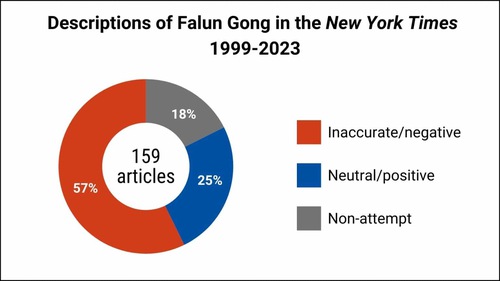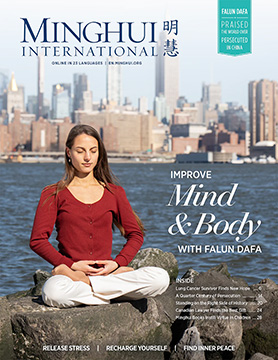(Minghui.org) Why does The New York Times, the “paper of record,” repeatedly fail to report on atrocities against Falun Gong, but instead amplifies the Chinese Communist Party’s (CCP) propaganda?
The CCP’s campaign to eradicate the spiritual group Falun Gong (Falun Dafa) is one of the most serious human rights crises taking place in China, affecting millions of people and costing billions of dollars. Yet it has been severely underreported, and its victims are discarded and maligned. The Falun Dafa Information Center (Faluninfo.net) published an investigative report in March 2024, and pointed out the following key findings.
 A collective analysis of the descriptions used in the New York Times articles from 1999 to 2023. (Source: Falun Dafa Information Center)
A collective analysis of the descriptions used in the New York Times articles from 1999 to 2023. (Source: Falun Dafa Information Center)
1. Widespread Misrepresentation
The New York Times coverage significantly and irresponsibly distorts the story of Falun Gong, be it in terms of the nature of the practice or the scope of the persecution. Failure to report or incorrect reporting carries wide-ranging implications for people in China and around the world.
2. Frequent Inaccuracies
The New York Times coverage on Falun Gong is riddled with factual errors. These range from relatively benign assertions to more damaging labels that fuel hatred toward the group. The paper’s characterization of Falun Gong’s teachings (Truthfulness, Compassion, Forbearance) and beliefs has been predominantly inaccurate and negative, and often follows the CCP’s verbiage. The image of Falun Gong that emerges from the coverage is at odds with the lived reality of practitioners, and evaluations of experts on Chinese religion.
3. Following the CCP
The New York Times coverage favored Chinese government sources when reporting on the violent campaign launched by the regime in July 1999, since its inception. The paper repeats, and has seemingly internalized, key aspects of the regime’s campaign. This persisted even when the claims contradicted The New York Times’ own early reporting and emerging research by human rights groups.
4. Silence About the Persecution of Falun Gong
For the past 20 years, The New York Times has been notably silent on atrocities against Falun Gong practitioners, including the forced organ harvesting from prisoners of conscience. Incredibly, the paper published no news stories focused on rights abuses facing Falun Gong practitioners in China since 2016, even as these violations continued on a large scale. The paper ignored major reports by human rights groups, the 2019 London China Tribunal on forced organ harvesting, as well as ongoing high-profile individual cases of prison sentences and deaths of practitioners while in custody. At least one former Times journalist reported being barred by editors from investigating organ transplant abuses against Falun Gong practitioners and other prisoners of conscience.
5. Sharp Contrast to Competitors
The New York Times coverage of the Falun Gong human rights crisis during its nascent stage was significantly different from other major papers. While The New York Times was seemingly preoccupied with distorting the facts about Falun Gong’s beliefs and improving ties with the Chinese communist leadership, its peers like The Wall Street Journal, Washington Post, and others, produced ground-breaking investigations and award-winning journalism about the human toll the crackdown was taking, and inaccuracies in the regime’s propaganda against Falun Gong. Jumping ahead to 2019, outlets like The Guardian and Reuters reported on the findings of the China Tribunal, which The New York Times ignored.
6. Contrast in Coverage of Uyghurs and Tibetans
The New York Times silence on Falun Gong is even more stark when its compared with the paper’s coverage of human rights crises facing other religious and ethnic groups in China, namely Uyghurs and Tibetans, whose population is much smaller than the Falun Gong community in China. Since 2009, the paper has published hundreds of articles, including investigative reports and sympathetic profiles of individual Uyghur and Tibetan prisoners, as well as dozens of op-eds by scholars and members of these communities. In contrast, it published only seven stories about the persecution of Falun Gong, and not a single op-ed by a Falun Gong practitioner.
7. Increasing Distortion Over Time
In recent years, The New York Times coverage has become even more problematic. Alongside complete silence on rights abuses facing Falun Gong practitioners, the few articles it did publish about Falun Gong have been openly hostile, targeting organizations founded by practitioners. These negative articles repeat prior inaccuracies, incorporate new ones, and in practice, serve the CCP’s goals of maligning Falun Gong and stymieing the Party’s critics.
8. Lost Lives and Information Gaps
The impact of the paper’s distorted reporting and irresponsible treatment of Falun Gong practitioners as “unworthy victims” has contributed to the impunity enjoyed by perpetrators, and robbed their victims of vital international support, undoubtedly resulting in greater suffering and loss of life throughout Mainland China. Given the strong intersection between the regime’s campaign against Falun Gong and topics central to daily life in China—Internet censorship, public surveillance, forced labor, and rule of law deficiencies—The New York Times’ silence on Falun Gong has deprived policymakers and businesses of critical information for navigating today’s China.
9. Beneficiaries of The New York Times Distortions
The Chinese regime benefited immensely from the paper’s coverage, gaining traction for its agenda to marginalize Falun Gong and obscure the crackdown against it, while also providing credibility to anti-Falun Gong propaganda, domestically and globally. Meanwhile, The New York Times avoided being penalized by the Chinese regime (and perhaps even gained favors) by taking a hands-off approach to reporting on the CCP’s systematic campaign of religious persecution against Falun Gong.
Reporter’s note: I couldn’t help but notice that The New York Times, founded in 1851 by Henry J. Raymond and George Jones, has always covered political, social, and cultural issues in serious style with in-depth reports. For decades it established a good reputation and was once the largest liberal newspaper in the U.S. dedicated to providing its readers with high-quality news content. However, this once-trusted newspaper built by generations of hard work has fallen in the past 26 years due to misreporting, false reporting, and failure to report on Falun Gong. These issues bear practical and important impact on the world and The New York Times itself. What is the reason behind this?
Copyright © 1999-2025 Minghui.org. All rights reserved.
Category: News Commentary








